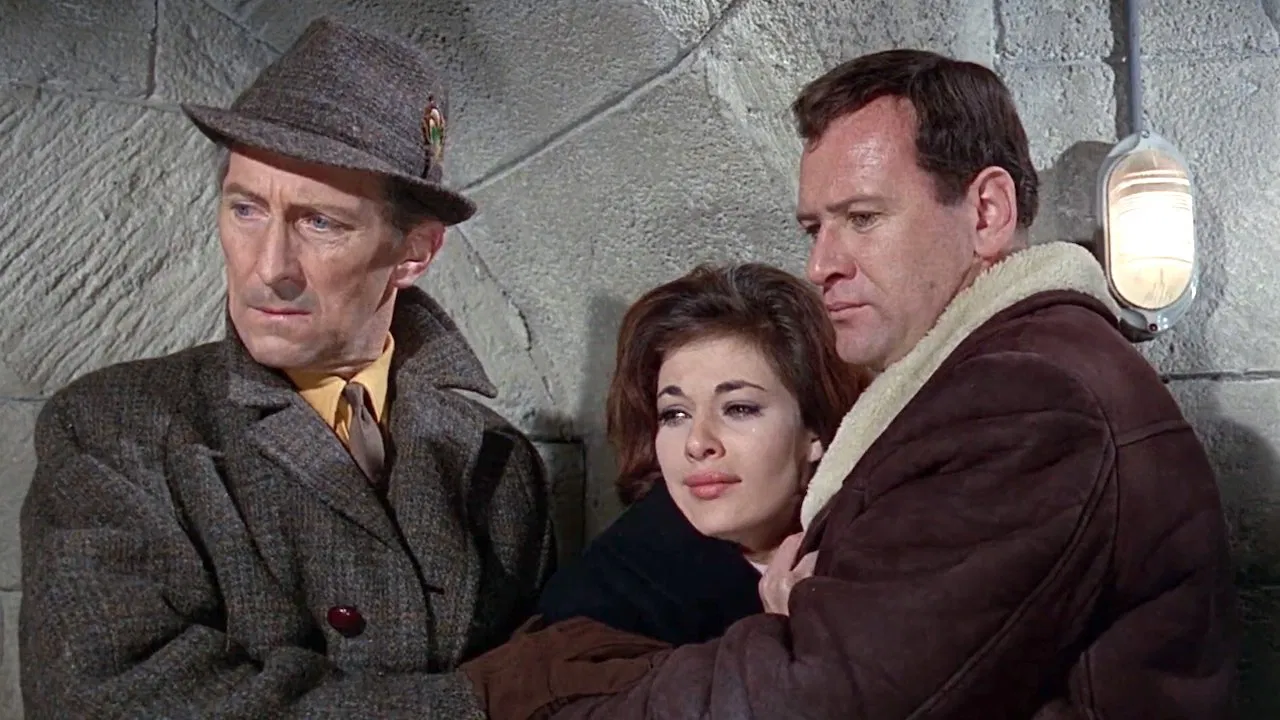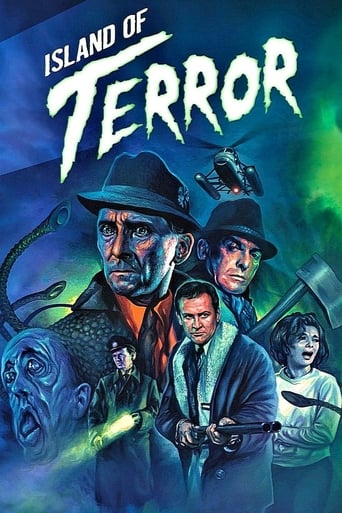

Really Surprised!
... View MoreFilm Perfection
... View MoreDreadfully Boring
... View MoreIt's an amazing and heartbreaking story.
... View MoreReclusive oncologist Dr. Lawrence Phillips is on the verge of curing cancer. He and his assistants have set up shop on the remote Petrie's Island, somewhere off the coast of Ireland, an island with no working phones, a weekly visit by a supply ship, and only one cop. Dr. Phillips' experiment is reaching a head, when, suddenly, something goes wrong. There is a flash of red light, and some breaking glass...That night, local farmer Ian Bellows is walking home through the woods when he hears a strange, electronic warbling noise coming from inside a cave. He decides to investigate...When Ian doesn't return home, his wife contacts Constable John Harris, who finds the waylaid farmer in the cave after searching the forest. But his corpse is in such a state that Harris rushes to get Dr. Reginald Landers, the island's doctor. An examination of Ian's corpse confirms Landers' worst fears; the dead man is completely boneless! At his wit's end, Landers heads to the mainland to see his old friend Dr. Brian Stanley in London. Unfortunately, although Stanley is Britain's foremost pathologist he has never heard of a disease that dissolves human bone.Undaunted, Stanley takes Landers in turn to see hotshot young osteopath Dr. David West, currently attempting to talk his way into the pants of Toni Merrill, a former patient. West is confounded by the tale of a boneless corpse, but agrees to return to Petrie's Island with the other two doctors. Toni, who has a rich father, offers the use of daddy's private helicopter with which to fly to the island, provided the three men let her tag along. Upon arrival however, Toni's father requires the chopper for some last-minute business. The pilot is forced to drop the four people off at the island and then fly away, leaving them effectively stranded until he can return.The doctors set immediately to work. They discover Ian was injected with a new enzyme that dissolves calcium phosphate, but can't figure out what produces it. The local clinic doesn't provide sophisticated enough equipment, so Landers suggests they go and see Dr. Phillips, as Phillips' laboratory, located in an old mansion in the woods, is better equipped. Upon arriving however, they discover that Phillips and his assistants are all just as dead as Ian Bellows... and just as boneless. Reasoning that whatever Phillips was mucking around with started all of this, West, Stanley and Landers gathers up the dead scientist's notes to study them.As soon as they've left, another farmer comes to complain to Constable Harris that one of his horses has been found dead and, shall we say, relieved of its skeleton. Harris hurries to the mansion, but misses the doctors. Doing a little exploring of his own, he is drawn to one room they didn't go into by a strange electronic warbling... only to be seized by the throat by a green tentacle!A minor cult classic of British horror that has sadly fallen through the cracks of time, 1966's Island of Terror is a movie that certainly deserves more fame than it's gotten over time (especially a proper American DVD release!) due to some stellar performances by a mostly unknown cast, headed by stalwart Peter Cushing, and also due to its frankly creepy central premise.
... View MoreDespite the presence of Terence Fisher and Peter Cushing, ISLAND OF TERROR is not a Hammer production. Surprisingly--because besides the star and director it has all of the assets we attribute to Hammer: an intelligent script hinged around a far-fetched premise; an expert cast including some outstanding character actors (in this case, a sadly wasted Niall MacGinnis); and modest but substantial production values bolstering what might best be called resourceful special effects.Produced in the days of the double bill, its 89 minutes fly by—just enough time to be convinced by ISLAND OF TERROR's imaginative calcium- sucking "silicates." The unlikely products of cancer research, the silicates look like huge oyster-shells with a single tentacular proboscis waving from (what one presumes is) the front end. Slow-moving but sneaky, their presence is announced by creepy (and for 1962, groundbreaking) electronic sound effects, and their deadly tentacles overtake even the wariest interloper. These uniquely-conceived monsters are just one of ISLAND OF TERROR's many pleasures, along with the ingenious (but hard on cattle) scheme our heroes devise to overcome the menace, the embattled island (inhabited by a couple of hundred people, who among them unfortunately have only one boat) mise-en-scene, and (SPOILER ALERT) the wacky sense of humour the previously dour Cushing develops after having his arm chopped off.Let us not underrate ISLAND OF TERROR; its craftsmanship stands up a half-century later, when more "serious" efforts from the same decade merely look embarrassing. It has many genuinely scary moments, including a classic, "it's-not-over" denouement, which make it a genuinely pleasurable movie experience.
... View MoreDirector Terence Fisher who also created another classic flick, Dracula 1958 has created another gem in Island of Terror.Starring Peter Cushing who was also in Terrence Fisher's classic flick, Dracula 1958.Also starring Edward Judd.Also starring Carole Gray.I enjoyed the special effects.If you enjoyed this as much as I did then check out other classic sci-fi flicks, Nineteen Eighty-Four 1984, The Chronicles of Riddick 2004, Dune 1984, Equilibrium 2002, The Island 2005, Knowing 2009, Light Blast 1985, Metropolis 1927, Pitch Black 2000, Rollerball 1975, Steel Frontier 1995, Tetsuo 1989, Tetsuo II: Body Hammer 1992, Things to Come 1936, THX 1138 1971, Dredd 2012, Annihilation 2018 and Videodrome 1983.
... View MoreTom Blakely's Planet Productions made just four features, three of which were this film, 1964's "Devils of Darkness," and 1967's "Night of the Big Heat" (their last). For ISLAND and NIGHT, they secured the services of Hammer director Terence Fisher and Hammer star Peter Cushing, adding Christopher Lee to the cast of NIGHT for extra measure. DEVILS was an odd footnote, the first British vampire film set not in the Gothic world represented so well by Hammer, but in the modern day, otherwise undistinguished. Terence Fisher expressed no fondness for science fiction, and his early black and white Hammer entries, "Four Sided Triangle," "Stolen Face," and "Spaceways" (all 1952), are all overly talkative and extremely dull. 1964's "The Earth Dies Screaming" was a modest step up, a very low budget alien invasion represented by a tiny cast and one single robot. Fisher's two Planet features make quite a matched set, perhaps not as revered as his better known Hammer efforts, but allowing him to focus on his cast of characters, presenting them in dangerous situations that create tension. Fisher always emphasized the human side of his monsters, and even in these two sci fi entries, he remains true to form. Both scripts benefit from finely etched characterizations, and wonderful actors bringing them to vibrant life. In ISLAND OF TERROR, an isolated island off the East coast of Ireland is the setting of an invasion created by scientists searching for a cure for cancer, creating a form of life that survives by devouring the bones of people and animals. Sam Kydd plays the constable, John Harris, who discovers a missing farmer dead in a cave, the body a mass of jelly. Eddie Byrne (THE MUMMY, THE VENGEANCE OF FU MANCHU, STAR WARS) is the island doctor, scoffing at the apt description of the corpse: "there was no face, just a horrible mush, with the eyes sittin' in it." Both actors, well known faces in British cinema, are so natural in these roles that the horror of the situation is instantly established with great credibility, and this is BEFORE the introduction of the heroic Peter Cushing, who never fails to convey sincerity in even the smallest of parts. Here, Cushing occasionally takes a back seat to second billed Edward Judd, but both work well in tandem, putting together the scientist's notes as to what went on in the laboratory, and learning how to stop the onslaught of terror. Cushing was usually the voice of reason, the authority figure, a character the audience trusts completely to present all the facts to them, yet here, his character is not so sure of himself, a quick quip to try to hide his fear, a more believably written hero, and this marvelous performer delivers one of his very best. The low budget special effects, especially the eating sounds, deliver on a modest scale, and the harrowing sequence where Cushing is attacked and implores Judd to chop off his hand at the wrist is the stuff of childhood nightmares. A first time viewer may be surprised at the unusual depth of characterization, and Niall MacGinnis (NIGHT OF THE DEMON, DR. TERROR'S HOUSE OF HORRORS, TORTURE GARDEN), as the island's leader, Liam Gaffney as the first victim, even the smallest of roles are played faultlessly. Of course, when one puzzled islander remarks "some peculiar goings-on going on on this island," there's always a risk that unintended humor might overcome the intended, but it's not fatal. Superior to NIGHT OF THE BIG HEAT, and proof that Terence Fisher could make excellent science fiction, provided he had a script that presented human characters little different from the ones in his Gothic chillers. Make no mistake, this is definitely a CHILLER, and one of Richard Gordon's infrequent productions, ranging from "Mother Riley Meets the Vampire" (Bela Lugosi), "Grip of the Strangler" (Boris Karloff), "Corridors of Blood" (Karloff and Christopher Lee), "Devil Doll," "Curse of Simba," "The Projected Man," "Tower of Evil" (all four with Bryant Haliday), "Horror Hospital" (Michael Gough), "The Cat and the Canary" (Carol Lynley), and finally "Inseminoid" (Judy Geeson and Stephanie Beacham). Thirty years of genre cinema with the greatest stars of their day.
... View More